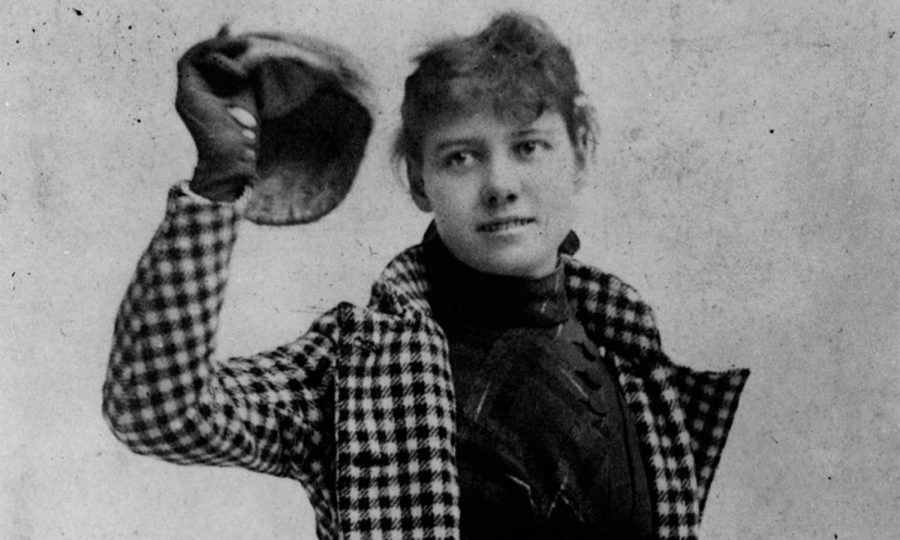The Life and Legacy of Nellie Bly
How a young girl from the suburbs of Pittsburgh changed the face of investigative reporting and the role of women in journalism
Nellie Bly, seen in the singular outfit she wore on her 72-day journey around the globe in 1889-90.
Alongside Steelers legend Franco Harris and President George Washington, a new face can soon be found in the Pittsburgh International Airport. A statue of the trailblazing journalist, suffragette, and adventure enthusiast Nellie Bly will stand tall this March next to other iconic Pittsburghers in honor of the 100th anniversary of women’s suffrage and in conjunction with National Women’s History Month.
Elizabeth Jane Cochran, known to many by her pen name Nellie Bly, was born in 1864 in “Cochran’s Mills” which is now part of the Pittsburgh township of Apollo in Armstrong County. After her father passed away, she and her family moved closer to the epicenter of Pittsburgh so that her brothers could have more opportunities to work. She was always full of moxie, though many underestimated her despite her attempts to become more sophisticated.
Around the early 1880s, Bly read a newspaper column in the Pittsburgh Dispatch entitled “What Girls are Good For.” The column essentially stated that women’s only role in society should be to housekeep and to raise children. Naturally, the argument upset the spunky, young Bly, so she wrote a response under the pseudonym “Lonely Orphan Girl.” This small act was the catalyst that launched her career as an investigative journalist.
George Madden, the editor of the Pittsburgh Dispatch, sent out an advertisement for the “orphan girl” to identify herself because he was highly impressed with her work and wanted her to write for the paper. Bly accepted the job and wrote under her new pen name, “Nellie Bly,” inspired by the African-American title character in the Stephen Foster song “Nelly Bly.”
Over the next few years, Bly’s career took off. She worked for the Pittsburgh Dispatch throughout her twenties, starting off by investigating and reporting about the lives of women working in factories. These factories began to complain to the newspaper about her reports, so she was reassigned to women’s fashion–a common column for female journalists to write about during that time.
But seeing as Nellie Bly was never satisfied reporting mundane topics, she became too antsy in this role and wanted to do more. So she took off to Mexico for six months to investigate and report on the lives and cultures of Mexican people. She even protested the imprisonment of a local journalist who criticized the government. Despite having to flee the country after Mexican authorities found out about her report, she published her findings in a book entitled Six Months in Mexico.
Bly had a voice, and she wasn’t going to let anyone stop her from using it.
In fact, after abruptly leaving the Pittsburgh Dispatch in 1887, Bly went to New York City and marched right up to Joseph Pulitzer of the New York World, leaving a note to the editors of the Dispatch simply stating, “I am off to New York. Look out for me. –Bly.”
It took her four months to land a job at the World, but she quickly undertook the writing of one of her most famous pieces: an undercover exposé on mental asylums’ brutal treatment of patients. Bly first had to get admitted to the Women’s Lunatic Asylum on Blackwell’s Island in New York, and to do that, she stayed at the boarding house “Temporary Homes for Females,” studied the women who seemed the most insane to her, and mimicked their actions. Her undercover name was Bly Brown.

Once at the asylum, she witnessed firsthand how terribly the patients were treated. The building’s conditions were very poor and unsanitary. Immigrants and non-native English speakers had it particularly difficult due to language barriers, cultural insensitivity, and refusal by the nurses to make an attempt to understand them. They were given cold baths and small, vermin-infested cells. Additionally, the doctor-to-patient ratio was nearly one to one thousand. Bly took vivid notes and published her findings in her book Ten Days in a Mad-House. This book soon led to the internal improvements of the establishment.
Some of her best known publications were results of other daring adventures. Not only did Bly write headlines, she often made the headlines herself. Her most famous journey was inspired by Jules Verne’s novel Around the World in Eighty Days (1873), a fictitious story in which Londoner Phileas Fogg attempts to circumnavigate the globe. Bly, being the adventurous spirit she was, decided she wanted to beat Fogg’s record (that no living person had actually set) and travel the world in 75 days.
She set off from Hoboken, New Jersey, at 9:40 P.M. on November 14, 1889, taking with her only the things she could carry. The whole time she would document her travels and experiences to report back to the New York World. Unbeknownst to her, the whole country was watching her journey. To maintain interest in the story, the World would run guessing game cards–similar to lottery tickets–in their papers for readers to guess down to the second when Nellie Bly would return and a chance to win a grand prize — a free trip to Europe.
Bly’s first stop was in Southampton, England. Upon arrival, she was asked to visit Jules Verne himself in Amiens, France. She did not want to delay her progress, but she went anyway and the two became fast friends.
Despite small setbacks, Bly ultimately arrived back in Jersey City at 3:51 P.M. on January 25th, 1890. Her travel time came to a total of 72 days, 6 hours, 11 minutes, and 14 seconds. She published her documentations in her book Around the World in Seventy-Two Days.
Bly passed away on January 27, 1922 at the age of 57, but her legacy still lives on. She has been the subject of or inspiration for many forms of entertainment, such as the short-lived 1946 Broadway musical Nellie Bly (Johnny Burke and Jimmy Van Heusen) and several television shows and movies. Even the character Lana Winters (portrayed by Sarah Paulson) from the show American Horror Story: Asylum was inspired by Bly’s observations of the Women’s Lunatic Asylum. In 1998, Bly was posthumously inducted into the Women’s National Hall of Fame, and the New York Press Club continues to give out an annual journalistic award in her honor.
Her hometown of Pittsburgh is also still honoring her iconic legacy. On February 4, Bly was the subject of a virtual program entitled “Trailblazing Women of Journalism: The Legacy of Nellie Bly,” presented by the Heinz History Center and the Women’s Press Club of Pittsburgh. The event also celebrated the 130th anniversary of the Women’s Press Club.
Nellie Bly was never one to turn down a challenge or an adventure. She revolutionized the field of investigative journalism as well as the role of women in journalism. She broke into a man’s world. She was a woman paving the way for other women in the world of journalism, and now the term “Nellie Bly” is used to describe a star female reporter. Today’s female journalists have the lonely orphan girl from Pittsburgh to thank for pioneering the future of investigative journalism.

Following her stint as the Co-Editor-in-Chief of the NAEye sophomore year and Junior Photography Editor last year for the Uproar, Jess Daninhirsch is ecstatic about being the Photography Editor and a staff writer this year on The Uproar. Jess dreams of becoming a journalist and a photographer one day and documenting the world. Outside of school, Jess actively participates in BBYO, an international...



Volpe • Feb 9, 2021 at 5:13 pm
I. Love. This.